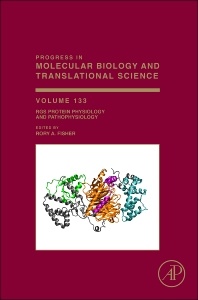Description
RGS Protein Physiology and Pathophysiology
Progress in Molecular Biology and Translational Science Series
Language: English
Subjects for RGS Protein Physiology and Pathophysiology:
Support: Print on demand
Description
/li>Contents
/li>Readership
/li>Comment
/li>
RGS Protein Physiology and Pathophysiology describes the current, state-of-the-art research occurring in the laboratories of leaders in the RGS protein field that utilize genetic mouse models to interrogate the function of RGS proteins in vivo.
Each chapter describes the elucidated role of a specific RGS protein or family of RGS proteins in normal physiology and/or disease with particular emphasis on how these discoveries inform healthcare and drug discovery.
The work is a timely reference as drugs targeting G protein coupled receptors represent 40% of currently marketed therapeutics.
- Introduction: G Protein-coupled Receptors and RGS Proteins
Adele Stewart and Rory A. Fisher - RGS-insensitive G Proteins as in vivo Probes of RGS Function
Richard R. Neubig - RGS Protein Regulation of Phototransduction
Ching-Kang Jason Chen - Role of Regulators of G Protein Signaling (RGS) Proteins in Bone Physiology and Pathophysiology
Joel Jules, Shuying Yang, Wei Chen and Yi-Ping Li - Regulator of G Protein Signaling 2: A Versatile Regulator of Vascular Function
Patrick Osei-Owusu and Kendall J. Blumer - Keeping the Balance Right: Regulator of G Protein Signaling 5 in Vascular Physiology and Pathology
Ruth Ganss - Two for the Price of One: G Protein-Dependent and -Independent Functions of RGS6 in vivo
Adele Stewart, Biswanath Maity and Rory A. Fisher - Physiology of RGS10 in Neurons and Immune Cells
Jae-Kyung Lee and Malú G. Tansey - Regulator of G Protein Signaling 14 (RGS14): A Molecular Brake for Synaptic Plasticity Linked to Learning and Memory
Paul R. Evans, Serena M. Dudek and John R. Hepler
- Brings together information on the current state of the RGS protein field
- Contains comprehensive descriptions of the known pathophysiological and physiological functions of RGS proteins, the first such undertaking
- Gives particular emphasis to the ways these discoveries inform healthcare and drug discovery
These books may interest you

The Rho GTPases in Cancer 158.24 €



